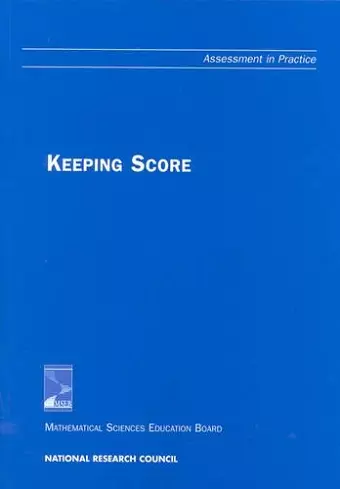Keeping Score
National Research Council author Mathematical Sciences Education Board author Center for Science, Mathematics, and Engineering Education author Ann Shannon author
Format:Paperback
Publisher:National Academies Press
Published:16th Dec '99
Currently unavailable, our supplier has not provided us a restock date

Curriculum reform, performance assessment, standards, portfolios, and high stakes testing-what's next? What does this all mean for me in my classroom? Many teachers have asked such questions since mathematics led the way in setting standards with the publication of the Curriculum and Evaluation Standards for School Mathematics (National Council of Teachers of Mathematics [NCTM], 1989). This seminal document and others that followed served as catalysts for mathematics education reform, giving rise to new initiatives related to curriculum, instruction, and assessment over the past decade. In particular, approaches to classroom, school, and district-wide assessment have undergone a variety of changes as educators have sought to link classroom teaching to appropriate assessment opportunities.
Since the publication of Everybody Counts (National Research Council [NRC], 1989), the Mathematical Sciences Education Board (MSEB) has dedicated its efforts to the improvement of mathematics education. A national summit on assessment led to the publication of For Good Measure (NRC, 1991). This statement of goals and objectives for assessment in mathematics was followed by Measuring Up (NRC, 1993a), which provided prototypical fourth-grade performance assessment tasks linked to the goals of the NCTM's Curriculum and Evaluation Standards. Measuring What Counts (NRC, 1993b) demonstrated the importance of mathematics content, learning, and equity as they relate to assessment. The MSEB is now prepared to present perspectives on issues in mathematics education assessment for those most directly engaged in implementing the reform initiatives on a daily basis-classroom teachers, school principals, supervisors, and others in school-based settings.
Table of Contents- Front Matter
- Chapter 1: Introduction
- Chapter 2: A Model for Assessment Development: Achieving Balance
- Chapter 3: Assessment and Opportunity to Perform
- Chapter 4: Assessment and Opportunity to Learn
- Chapter 5: Alignment and Standards-Based Assessments
- References <
ISBN: 9780309065351
Dimensions: unknown
Weight: unknown
96 pages